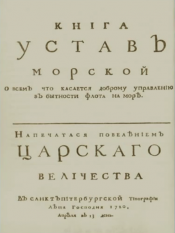
The Presidential Library’s rare materials present Peter I’s Naval Regulations - "One of the most important works of His Majesty"
On April 24 (13 according to the old style), April 1720, the first edition of the Naval Regulations, printed in the St. Petersburg Printing House, was published.
The "Sketch of the History of the Naval Regulations, published under Peter the Great" by the military writer, Lieutenant Commander Ivan Seidel, included in the book Materials for the History of Russian Maritime Law (1859) notes that "the decree on the publication of the Regulations was signed on January 13, 1720 therefore, it must be honored by the law in force from that date; meanwhile, others attribute its promulgation to April 13, 1720, that is, to the time of its printing. The edition of these Regulations came out in three forms, namely: one sheet in Russian and Dutch ... the other two in eight pieces, of which one in Russian and Dutch, and the other in one Russian ... <...> ... The first prints of it were sent out by the Sovereign to various persons, by the way, to France and Holland, and one copy, richly bound with a gold edge, was personally presented by the Tsar to the commander-in-chief of the Russian fleet, Vice-Admiral Sievers".
The history of the Naval Regulations of the Russian Empire with its texts from different years is available in the electronic reading room and on the Presidential Library’s portal which includes a video lecture The Naval Regulations of Peter the Great and the Military Legislation of Peter the Great (2014) by Candidate of Historical Sciences, Associate Professor Nikolai Rogulin.
The historian of the navy, captain 1st rank Sergei Yelagin in the above-mentioned book Materials for the history of Russian Naval legislation says that even during the reign of Alexei Mikhailovich, captain David Butler submitted to the embassy order a list of 34 articles. However, it was not possible to apply them to the case and they are in the archive for many years.
Therefore, the author continues, the first printed rules, Military instructions and articles due to the Russian fleet, appeared only in April 1710.
The Russian historian Ivan Golikov, in the 7th part of the book The Deeds of Peter the Great, the Wise Transformer of Russia (1789), gave the following assessment to this document: "These Regulations are one of the most important works of His Majesty; it consists of five books, divided into 60 chapters, and from the addition of the forms to the tables and signals for all occasions, and all this is described by the wise Monarch with such accuracy and detail that not the slightest bit of bewilderment is left for everyone in the fleet..."
The first book of the Regulations of Peter I contained provisions on the highest command personnel of the navy and articles that determined the tactics of the squadron. The second included decrees on seniority of ranks, on honors and external distinctions of ships, "on flags and pennants, on lanterns, on salutes and trade flags ...". The third book revealed the organization of the battleship and the duties of the officers assigned to it. The fourth book consisted of six chapters, which regulated the rules of conduct on the ship, the number of officers' servants according to ranks, the procedure for distributing provisions, methods for determining remuneration for the capture of enemy ships, battle wounds and length of service, as well as methods for dividing the spoils when capturing enemy ships. Book Five - "On Fines" - was a naval judicial and disciplinary regulations. Also, the Naval Regulations were accompanied by forms of ship reports, a book of signals and the rules of the patrol service, according to the On This Day section on the Presidential Library’s portal.
Since 1925, in the Red Army Naval Forces, it began to be called the Ship Charter, since 1939 it is the Ship Charter of the USSR Navy, and since 1995 - the Ship Charter of the Russian Federation Navy. The new Ship Regulations came into effect on September 1, 2001.
The Presidential Library’s collections provide an extensive collection of materials about the past and present of the Russian fleet, which is constantly growing thanks to cooperation with the specialists of the Navy and the teaching staff of higher educational naval institutions.
The Presidential Library annually hosts the Naval Knowledge Day and since 2015 - the Cadet Day for pupils and representatives of Russian cadet corps.

